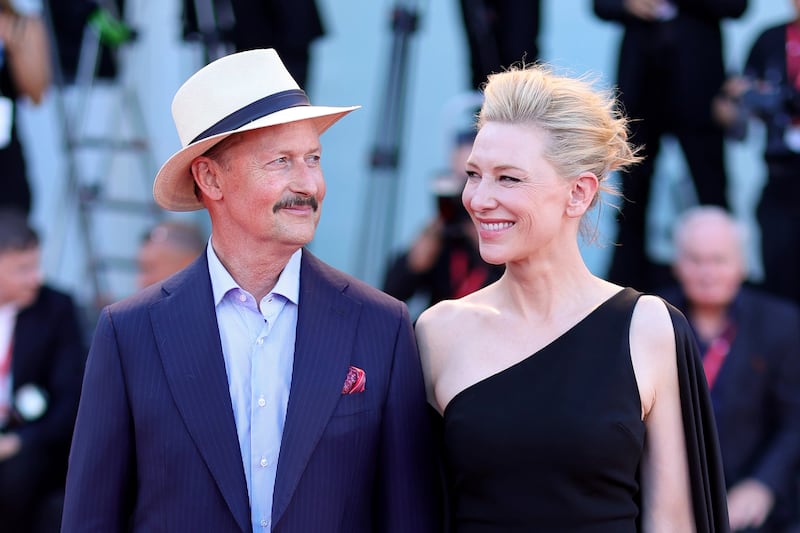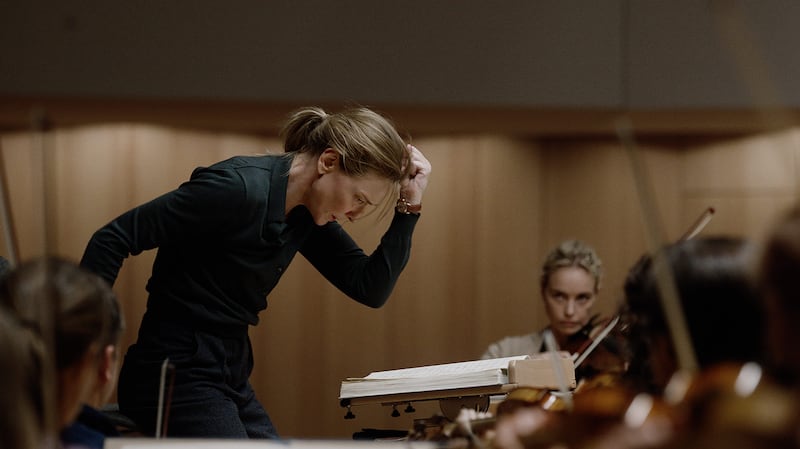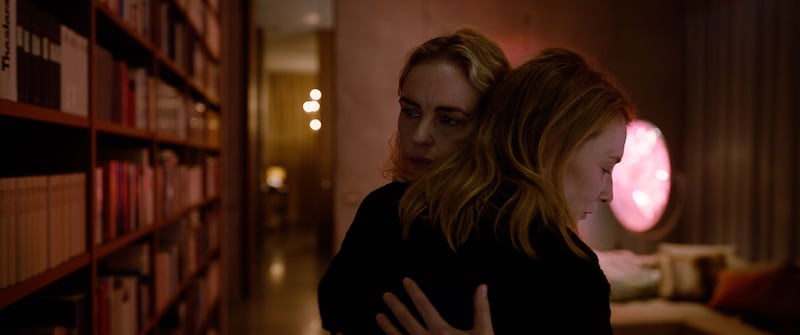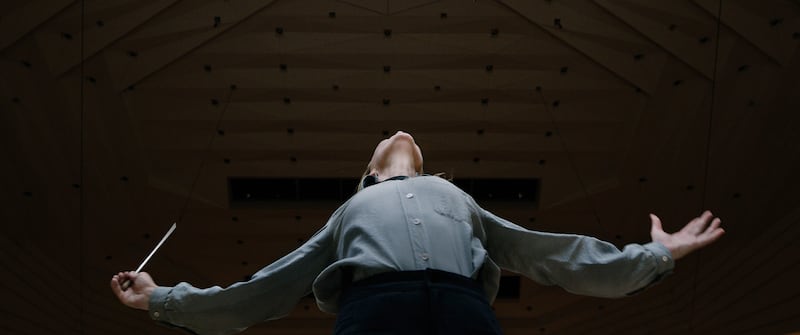It has been a long time since I last met Todd Field. Sixteen years to be precise. It was back in 2016 that he released his gruelling adaptation of Tom Perrotta’s Little Children. The film received rave reviews and picked up three Oscar nominations. Somehow or other, Field didn’t direct another feature until now. What the heck happened?
“I don’t know. I keep asking myself the same question,” he says in a reasonably merry voice. “I was directing that whole period of time. I was doing advertising. But, in terms of projects that I wrote, some came very, very close. We had close encounters. We just never beamed up to the mother ship.”
What a way to re-enter the atmosphere (to mix our metaphors a tad). It is the second day of the Venice Film Festival and I am peering up at the balcony of the Salla Grande. Field, tropical in straw Panama hat, and Cate Blanchett, horticultural behind a shoulder-load of blossoms, enjoy one of the more sincere standing ovations at the event. Tár, starring Blanchett as the first woman director of a large German orchestra, would go on to become the most chewed-over film of the current awards season. There is something in there about the demands of genius. There is something in there about contemporary censoriousness. There are hints of the macabre.
It is some measure of the film’s psychological traction that more than a few viewers went straight from their screenings to Wikipedia. Many felt that Lydia Tár, the icy protagonist, must be modelled on a real person. Why is that?
READ MORE

“I think that is a testament to Cate’s artistry and to her execution of this character,” Field says. “When we first meet her, she’s observed. And the second time we meet her it’s more neutral. The third time we see her she’s on stage being interviewed. If you don’t buy into that interview and you don’t believe that you’re literally, honest to god, listening to a master of their craft then the rest of the movie is not going to work for you. She has to convince you that Lydia Tár is real. And she does that through her own craft.”
The scene he mentions finds the conductor being quizzed lengthily and in real time by Adam Gopnik of The New Yorker. Field says that this sense of Tár being based on a real person comes from Blanchett’s performance. There is truth in that. But it also springs from the rigorous assembly of details about the character’s wider life. Since the premiere there has been debate on social media as to what sort of film would have won Tár the Oscar in her EGOT (the acronym for an Emmy, Grammy, Oscar and Tony winner). It feels as if Field knows every detail about his fictional character’s busy life.
[ Cate Blanchett: ‘I wouldn’t do what Harvey Weinstein wanted’Opens in new window ]
“Well, I do that with every character,” he says. “Sometimes I’m working on literary material. Oftentimes I’ll be collaborating with the author of that literary material and I’ll ask them the same questions you’re asking me. Sometimes they’ll have answers for those questions. Sometimes they won’t. And when they don’t, I get very suspicious.”
Field has taken an intriguing route to his current standing. Born in California, he was raised largely in Portland, Oregon, son of a salesman dad and a librarian mom. Few profiles will avoid pointing out that, as a teenager, he helped develop a class of bubblegum – modelled on chewing tobacco – that still sells under the name Big League Chew. Jazz had already captured him and he briefly attended Southern Oregon State College on a music scholarship.
We’re at a point where generations are screaming at each other, and there’s little nuanced conversation happening
He soon moved to New York with a mind to becoming an actor. You can spot him in Woody Allen’s Radio Days and, most memorably, as Nick Nightingale in Stanley Kubrick’s Eyes Wide Shut. Would I be wrong to assume that his musical training was useful in helping Blanchett accommodate herself to the life of the conductor?
“Well, her preparation began in the middle of the lockdown,” he says. “So, her challenge was doubly difficult. She had to learn to conduct over Zoom. She had to be with [conductor] Natalie Murray Beale on the other end of a Zoom call. That’s how it began. She had to learn to play piano that way. She had to learn American and German dialects that way. There was nine months of that. And then there was a diminuendo out of the pandemic into the spring of 2021.”
Let’s get to the meat of the issue. If you have heard more than two things about Tár you will have heard that it engages with “cancel culture”. But does it? The complications eventually encountered by Lydia Tár are handled in sufficiently oblique fashion to leave one uncertain about where the film sits. An early scene set at the Juilliard School has already convinced some that Field has it in for snowflakey Generation Z and others that he has it in for arrogant Generation X.

“Well, I’m very happy about that conversation,” Field says, amused. “And I’m happy that certain groups have claimed it for their own polar opposites. That’s very, very exciting.”
While teaching a class, Lydia encounters a student who expresses hostility towards JS Bach because of his sexual immorality. The young man goes on to call up the buzzwords that are guaranteed to set contemporary discourse reeling. “As a Bipoc pangender,” he says, “I have difficulty connecting with Bach – and wasn’t he a misogynist anyway?” Tár isn’t having it. “You’ve got to sublimate yourself. Your ego and yes your identity,” she says, taking a first step towards a reckoning.
“In terms of the intent behind the scenes, it really came at a very simple one,” Field says. “We’re at a point where generations are screaming at each other, and there’s little nuanced conversation happening. Rhetoric and debate have been ghettoised as something that is only for evil=doers – as opposed to being a tool for finding mutual ground and hopefully, some kind of understanding. A route to finding understanding, to walk a path together.”

He continues in unfashionably balanced fashion.
“She uses all kinds of tactics to try to bring him over on her side,” he says. “Humour, seduction, mockery. Finally, she launches into vitriol. Is there truth in what she’s saying? Sure. But is the methodology sound? That’s another question altogether.”
The notices for Tár have been almost uniformly ecstatic. Those few complaints that have bubbled up have tended to argue that the film is siding with the increasingly awful protagonist. “The drama is centred on accusations of improprieties levied against Lydia and presents her as a victim,” Richard Brody wrote in a much-discussed review for The New Yorker. What does Field make of the word “victim”?
It has taken until the last decade for women directors to get any sort of purchase on the reins of studio pictures
“I don’t see her as a victim at all,” he says. “She’s reached that point in her career where she’s sitting atop a pile – a real pile, a cultural pile – of bureaucracy. A power structure that has to do with certain political currency and winks and nods and decision making based on, yes, logic and experience, but also capriciousness and hypocrisy and all other kinds of human messiness.”
[ 50 films to see in 2023Opens in new window ]
He goes on to offer a fascinating alternative reading of the striking end sequence (that we won’t spoil here). One is, of course, always aware that Lydia Tár is a pioneer in a man’s world. Field cites Antonia: A Portrait of the Woman, a documentary on the Dutch conductor Antonia Brico, as an inspiration for his film. He explains how, deprived of a significant post later in life, Brico railed against being muted and silenced. “But she refuses to be a victim,” he says. There is surely an analogy here with the film business. It has taken until the last decade for women directors to get any sort of purchase on the reins of studio pictures.
“Well, certainly there are parallels,” he says. “When Antonia Brico started out, she had opportunities. And if you look at early Hollywood, women directors, in the silent era, were everything. Women script writers were everything. They were big, big box office. They were stars. They were technical stars. All of that shifts when they go into talkies, and the studios form these big consortiums – and they’re all run by men.”

He goes on to point out that, over the last few years, further unwelcome developments have taken place.
“The multiplex is a dodgy place for a certain type of film and I don’t know if I want to endure that,” he says.
Here we come to a tricky issue. I have enough diplomatic nous not to point out that, over the last few weeks, Tár has been cited – notably in an article by Variety – as an example of an awards-friendly, upper-browed title that has struggled to take cash. Everyone may seem to be discussing the film, but the US box office figures have been modest. The time when films by Francis Ford Coppola and Robert Altman topped the charts may as well be centuries ago. One wonders if, in future years, studios will only finance films such as Tár as a way of securing Oscar nominations.
“Well, that’s a very good question,” he says. “And it’s a question I’ve been asking myself. They publish box office numbers. But they don’t publish any other numbers. If you look at the box office numbers for speciality films, you do have to wonder what the upside is. If you saw the premium video-on-demand numbers, you might say: ‘Okay, there’s the upside’. But we don’t know those things. It’s changed so quickly, partly due to the pandemic. It’s really about delivery and desire. How do you keep people wanting to have a collective experience?”
He manages to laugh drily when I wonder if it will be as long before we meet for the next film.
“Well, I hope so, Donald. It was nice talking to you again. Ha, ha!”




















